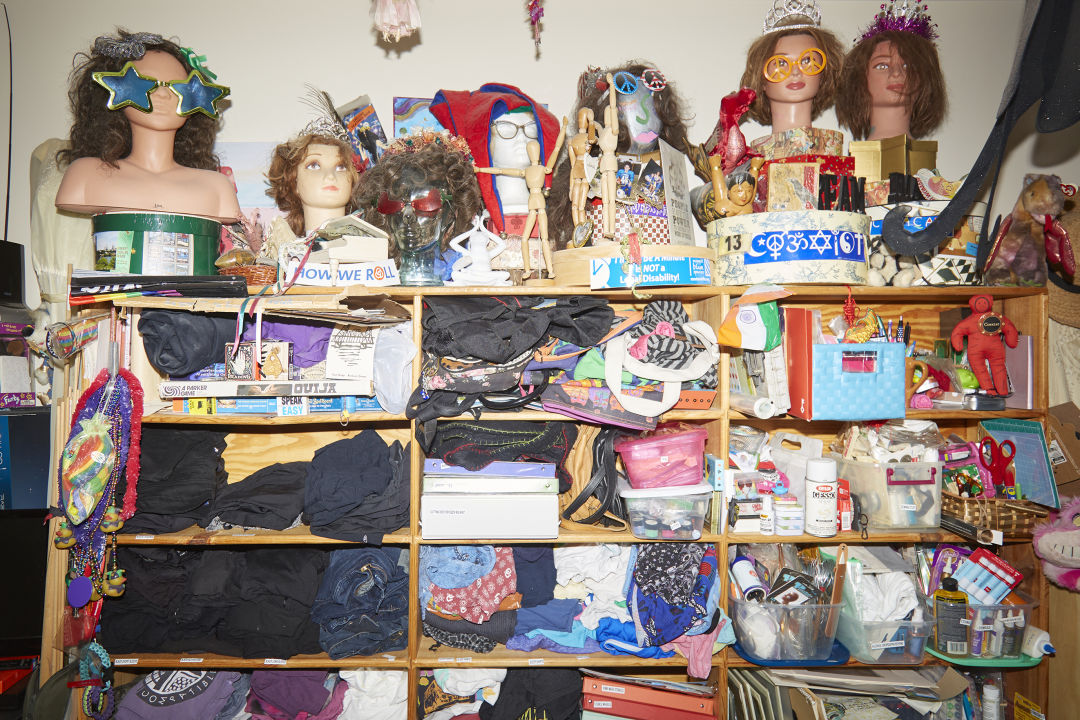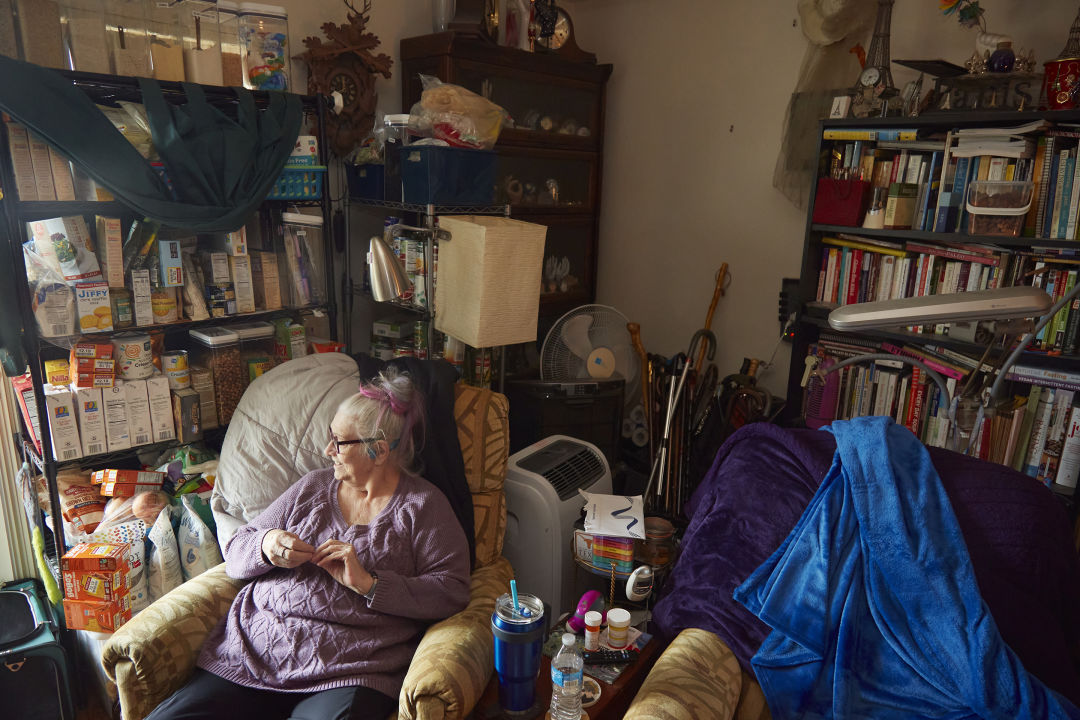Hoarding Disorder Appears to Have Increased in the Pandemic

The organized chaos of Shirley Hand’s apartment in downtown Portland
Image: Jordan Hundelt
Twenty-one utensil holders cover the counter of Shirley Hand’s small kitchen. Ladles, spatulas, tongs, pizza cutters, strainers, peelers, and whisks are neatly organized. Two dozen or so walking canes are carefully placed in one corner of the living room, surrounded by an assortment of books, household goods, clocks, and knickknacks condensing the small space even further.
In the other room, Hand’s bed is neatly made—the blue, white, and gray lines of her comforter tightly forming to the shape of the mattress—and two pillows lie freshly fluffed. “I refuse to sleep with stuff on my bed,” she says. “For the longest time I curled up in one little area and everything else was stacked beside me.” It’s a sign that she’s improved, even if only slightly—that her possessions no longer encroach on her while she dreams.
Beyond her bed, however, Hand’s two-bedroom apartment in downtown Portland is in a permanent state of organized chaos, a collection of multiples acquired over the years, stacked and stored. Bins fill the hallway, and clothing and bags and crafting materials and mannequins fill her bookcases, miraculously staying put in peculiar positions. In one corner, three lampshades are stacked, one upon another, serving no other purpose than “My daughter might want them,” she says.

Shirley Hand in her downtown Portland apartment
Image: Jordan Hundelt
Hand, 74, lives in subsidized housing and has struggled with hoarding disorder for well over 40 years. It’s a misunderstood and stigmatized mental illness, often misinterpreted and portrayed by reality TV shows as life spent in squalor and filth. But hoarding disorder can take many shapes and forms, defined mainly by the need to hold onto things that might still serve a purpose, for someone, at some point. It’s about comfort and the thrill of acquisition, or the difficulty to part with possessions, that eventually begin to debilitate and restrict. And, according to Portland housing and hoarding professionals, the pandemic has made it much worse.
“What I’m hearing across the board from property managers is that for those with hoarding tendencies, the violations are much more severe,” says Miley Stanton-Flowers, an eviction prevention specialist and a facilitator of the support group Buried in Treasures (BIT). “Some people who didn’t necessarily have any problems passing inspections prior to COVID are now struggling, and that’s impacting their ability to pass new inspections.”
Stanton-Flowers—who also works for a Portland-based housing provider—is referring to mandated inspections for those with housing assistance to ensure safety standards are met. Hoarding disorder is not limited to people on housing assistance, of course, but it is more likely to be noticed by professionals who try to prevent their eviction—something that can happen when residents consistently fail these inspections.
“Conventional housing and home ownership hoarding situations are often unreported and usually unknown unless it becomes a city code violation or concerned family members intervene,” Stanton-Flowers says. “Private landlords aren’t required to inspect on any certain timeline, and affordable housing providers are usually required per their contract to inspect annually—so obviously there’s a greater chance of finding a hoarding situation in affordable housing.”
Some landlords will conduct inspections despite having little understanding of hoarding disorder or other mental illnesses, which can lead to unnecessary evictions. “A lot of property management companies have service coordinators to help residents connect to the services they need,” Stanton-Flowers says. “But there are also a lot of property managers who don’t have that luxury.”
Without proper training or understanding of resources, landlords can unintentionally make it difficult for someone who hoards to understand the threshold needed to pass inspections (such as cleared egress). However, this is something that the Multnomah County Hoarding Task Force, of which Stanton-Flowers is a member, is trying to improve by encouraging landlords to go beyond the scope of their duties.
“We try to provide education to property managers,” says Jill Williams, a behavioral health specialist and cochair of the task force. “The more specific and encouraging you can be with people, the better chance that they’re going to be able to pass.”
Professionals such as Williams, Stanton-Flowers, and Laura Golino de Lovato—the executive director of the Northwest Pilot Project, which provides housing assistance and advocacy to low-income seniors—believe that when the pandemic hit, people were stripped of essential support systems. Home health or cleaning services, family visits, and even housing inspections kept people in check. The virtual disappearance of those safeguards exacerbated hoarding tendencies.
“I was forced to live in a prison of my own making,” says J. L., whose name has been withheld to protect her privacy. “It was emotionally distressful. I couldn’t get away from it. I did get together with people occasionally but the few people that were willing were very, very, few.”
Although these annual inspections can encourage people to clean their units, they can also be incredibly stressful. J. L. says she tends to admit herself into a psychiatric facility around the time of the inspection and that she finds other ways to circumvent them. One year, J. L. and her daughter rented a moving truck to temporarily house her possessions. After the inspection, they put everything back. J. L. says she barely passed her inspection last year.
J. L. and Hand (who has failed an inspection in the past) both use storage units to decrease the number of possessions in their homes, adding significant financial burden. Of the roughly $947 that Hand receives each month from Social Security, she spends $324 on storage units and $217 on rent—leaving her with only around $100 a week. J. L.’s situation is no better. A couple of years ago, she says, she missed payments and the contents of her storage unit were auctioned off.
Part of the problem is that knowledge of and research into hoarding disorder as a mental illness is sparse compared to other issues. Only one study with a small sample size has been published in the past two years showing an increase in hoarding disorder during the pandemic. At least 50 percent of people with hoarding disorder also suffer from comorbidities (the existence of more than one disease or condition within your body at the same time) such as depression or anxiety, both of which saw substantial increases during the pandemic, and can exacerbate hoarding tendencies.
Hoarding disorder tends to be stigmatized because of the visibility of its symptoms. It can be easy to suggest that simply getting rid of their “stuff” will fix the problem, but this bypasses the mental issues that underlie the hoarding. “You wouldn’t address someone’s substance abuse by going into their apartment and throwing away their drugs,” Williams says. “We have seen people that have had these drastic clean outs, where someone comes in and takes all their stuff, and within weeks the unit is full again.” It’s also often seen as something that the person has brought onto themselves, or a result of trauma. Both are incorrect.
Moreover, cleanouts can be traumatizing to sufferers of hoarding disorder. “The cleanout set me back emotionally where I needed even more therapy,” J. L. said. “To get past feeling like I was violated.”
The solution, experts believe, comes down to slow and concrete steps to address residents’ violations and hoarding tendencies by prioritizing sanitation and safety. To achieve this, those who conduct the inspections can play a vital role. “Housing providers have an especially difficult job because they are not necessarily equipped, nor is it in their scope, to provide intervention services beyond the mandated inspections,” says Christiana Bratiotis, an associate professor at the University of British Columbia. “But as housing providers identify these cases … they are a central player for linking [residents] to other services that can provide them more direct support.”
Fair housing laws provide some support and reasonable accommodations are available to those with a disability. This grants people with hoarding tendencies time to resolve the issue, but it doesn’t really address the mental illness that causes it in the long run. It simply helps people pass another inspection.
“It’s tough. Property managers do not have a lot of extra time to be coaching someone through decreasing their amount of stuff,” Stanton-Flowers said. “But it’s important that property managers at least try and engage in some sort of problem solving or solution instead of just flat-out evicting people.”
For organizations such as the Northwest Pilot Project, the plan is to get back to business—to start serving those they couldn’t during the pandemic and to catch up on what they missed. Stanton-Flowers, Williams, and the county hoarding task force will continue running workshops for property managers and residents alike, and hopefully get the attention of board of county commissioners. “The truth is, I am not sure that [commissioners] know this task force exists as we have no funding or designated position,” Williams says. “I have tried to get some attention over the years by holding large-scale events … [but] nothing has come down to me about plans to address this issue beyond the training and education we do.” County Commissioner Lori Stegmann did not respond to a request for comment.
Hand still struggles with acquiring and the number of possessions she keeps—something she believes will improve when her daughter moves out next year—but there are also signs of improvements. A couple months ago she was able to sell the contents of one of her storage units full of glass-making tools and materials from her teaching years; when she found just the right person to sell them to. Often, those with hoarding disorder hang on to things because they haven’t found a good way to get rid of them, either because they don’t want to be wasteful or because they want to make sure the items will be loved. Over the years, Hand has spent more than $7,000 to store her glass-making tools. She sold the items for $1,600.
“There was so much of me tied up in it,” Hand says. “The choices that I made, the money that I spent. It was like a gift to me when she took it because it felt right.”




